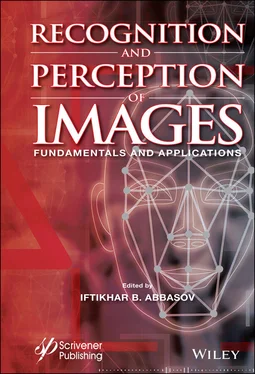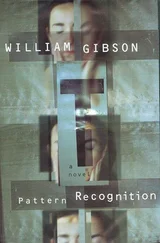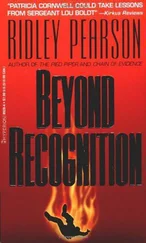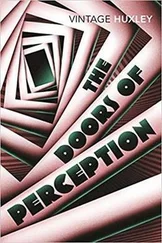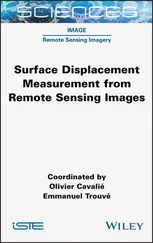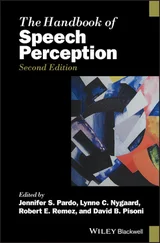
Figure 1.2.2 Determination of the sharpness of the resolution of the eye.
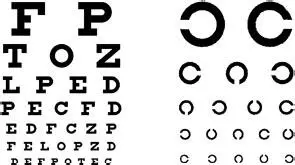
Figure 1.2.3 Snellen table and Landolt rings.

Figure 1.2.4 The stylized Landolt rings without the noise and with different noise level [Eremina, Shelepin, 2015].
The work of [Eremina, Shelepin, 2015] is dedicated to the study of visual perception by patients after cardiosurgical operations. The article describes the results of research of visual perception peculiarities and cognitive processing of visual images by the patients with ischemic heart disease. One hundred and seven middle-aged patients (62 years old) took part in the study. It was demonstrated that the capability to recognize the fragmented images declined immediately after the surgery (exemplified by Landolt rings, Figure 1.2.4). However, such capability is not only recovered but also surpasses the pre-surgical level in three months. Moreover, the patients undergoing surgery cope better with the offered tasks in three months after the surgery than patients getting non-surgical treatment.
1.2.3 Types of Eye Movement
Our brain usually tries to avoid emptiness, monotony, and an aggressive visual environment. The visual system highlights certain areas of the surrounding scene and controls the eye to recognize their details. The angle of view of a clear vision is about 2° of the visual field, and the oculomotor (oculomotor) muscles constantly make various movements to search for small objects. These movements allow you to direct the view in such a way that the visual stimulus is projected onto the central fossa, since this part of the retina is characterized by the most acute vision. Our eyes can both be fixed on the object and move continuously. Consider some publications in this area that describe the main types of eye movement.
The article of [Butenko, 2016] presents a brief description of types of eye movements and analyzes the methods and systems registering the oculomotor activity. The movement of the eyes is the natural component of visual perception. The eyes make micromovements even in the case of relative fixity of look. It is generally known that there are eight types of eye movements which belong to the micro- and macromovements.
The macro eye movements characterize the change of eye direction and can be controlled. They are divided into macrosaccades (sudden change of eye direction), accompanying movements (the sweeping drift of gaze after the moving fixation object), vergence eye movements (coupling and decoupling of visual axes), nystagmus (vibratory eye movements together with the accompanying movements) and torsional movements (rolling eye movements about the visual axis). The micro eye movements are the natural background of oculomotor activity that cannot be controlled. The micro eye movements are divided into the tremor (frequent eye vibrations), drift (sweeping drift of gaze interrupted by the micro jumps) and microsaccades (rapid eye movement occurring in the case of fixation points change).
Oculography (eye tracking) is a determination of eye position and meeting point of the eye bulb optical axis with the plane of observable object. The eye tracker is a device used to determine the orientation of the eye bulb optical axis in space. The eye trackers are applied in the course of study of the visual system as well as in psychology and cognitive linguistics.
The tracking methods can be divided into two groups: contact and noncontact. The first group is represented by the electro-oculography, photooptic and electromagnetic methods. The second group includes the photoelectric method and video recording.
The electromagnetic method is based on the change of equivalent stress in which any eye movement is transferred. The inductive emitter is fixed with the sucking cup (contact lens) on the eye bulb, and the receiver coils are placed around the head. The emitter establishes the alternating electromagnetic field in the receiver coils. The moving of emitter results in the change of electromagnetic field strength. Furthermore, the signal is amplified being transmitted to the input of recording oscillographs.
The photooptic method is based on the recording of reflected light when the sucking cup with the miniature mirror from which the narrow beam of light is reflected and fallen on the input of light-beam photographic recorder is set on the eye bulb. The photooptic method allows the analysis of the microformation of oculomotor activity.
Electrooculography. The measurement of potential differences in the tissues adjacent to the eyehole is a basis of electrooculography. The eye movements are recorded by means of electrodes set around the eye pits. The potential marker points at the gaze direction, and the variation value of potential difference indicates the rotation angle.
The photoelectric method is based on the transformation of infrared light beam reflected from the cornea into the electric signal. The amount of reflected light is changed in the course of eyes moving, and the photocurrent value is changed respectively.
Video recording. The video recording method embraces two interdependent procedures – the video recording of eyes of the test person and programmed determination of eye direction on each frame of video sequence. The pupil edge or center, sclera blood vessels or corneal speck is a source of information about the eye direction. The other kind of video recording method intends the eye lightening with the point source of infrared light and high-speed shooting by infrared video camera. This method is used in the devices produced by Tobii Company. Such eye tracking devices embrace: Tobii REX, Tobii EyeX, Tobii TheEyeTribe [Website tobii.com, 2020].
Let’s consider some current articles concerned with the study of oculomotor activity. The work of [Wegner-Clemens et al., 2017] is dedicated to the study of gaze fixation in the course of the viewing of faces. Although the human face features many visual peculiarities, observers prefer to fix their eyes mainly on the eyes and mouth. It is more explained by the evolution of social signs of recognition and human society communication.
The experimental findings of 41 participants looking at four faces with different starting stimuli were represented ( Figure 1.2.5). The blue ellipses on the face show the position of each particular eye fixation, and the size of every ellipse is proportional to the fixational pause. The degree of eye fixation on the face from the left side ( Figure 1.2.5) is presented in the form of thermal map. The degree of eye fixation on the faces is a useful tool to evaluate the individual differences and subsequent recommendations for social communication.
The article of [Ito et al., 2017] provides a new method to analyze the eye movements during the natural viewing. The method is based on the fact that eyes move from and to the objects of the visual scene. The method was used experimentally for two macaques freely looking at the visual stimuli in the form of scenes. The analysis revealed that monkeys had a behavioral shift from the free viewing to the focal processing of visual stimulus.
Читать дальше
